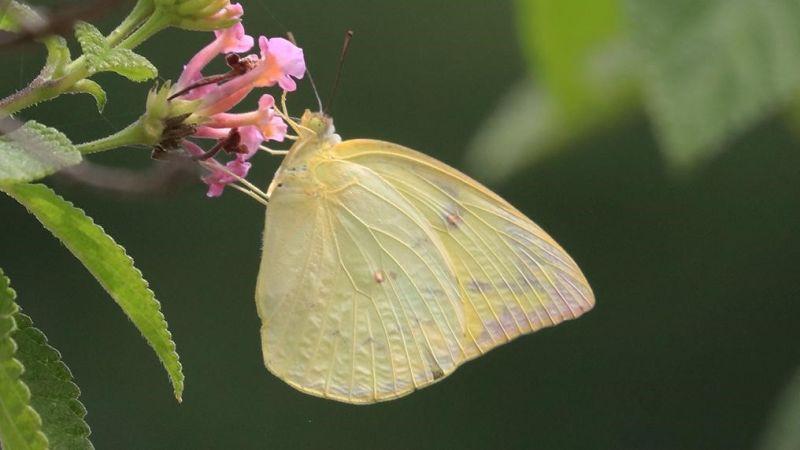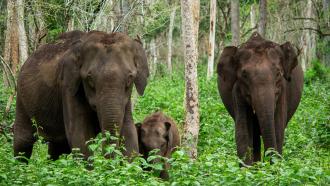
The lemon emigrant (Catopsilia pomona), one of the butterflies the researchers studied (Image Credits: Prof Krushnamegh Kunte).
Animals are known to leave environments that are less favourable to them in search of greener pastures. The great migration at the Serengeti, birds heading towards the tropics during winter and big swarms of locusts flying in to devour crops are all examples of such movements. While moving to previously-known places is easy, charting into unknown territories comes with its set of challenges. In the course of evolution, animal behaviour and survival are shaped by such trade-offs. In a new study, researchers from the National Center for Biological Sciences, Bengaluru, and SASTRA University, have studied what trade-offs drive movement of butterflies.
The study, published in the journal Biology Letters, examines how butterflies invest their energy between building strong muscles in the wings or on reproduction. Stronger flight muscles would help the butterflies move longer distances to find suitable habitats. However, suitable habitats would mean little if the butterflies are not able to lay eggs and reproduce successfully. This study, funded by the Council of Scientific Research (CSIR) and the Department of Science and Technology (DST), explores what different species of butterflies choose to do.
Migration is quite common among animals.
“Migrations are generally determined by predictable climatic factors such as changing daylength and temperature. Dispersals, or 'facultative' dispersals, as seen in the butterflies, can be more spontaneous and caused by a local decline in host plant quantity or quality,” explains Ms Vaishali Bhaumik, the lead author of the study.
In their caterpillar stage, butterflies depend on the leaves of specific plants, which are called their ‘host plants’. Different butterfly species have different host plants. The sprouting of leaves can be seasonal for many of these plants, and hence, the stock of fresh leaves for caterpillars is a precious and limited resource. A female butterfly has to carefully choose where she lays her eggs so that her offspring have the best chance at survival. If the leaves in her vicinity aren’t good enough, she has to move into a new place to lay her eggs.

The Mottled emigrant (Catopsilia pyranthe), one of the butterflies the researchers studied (Image Credits: Prof Krushnamegh Kunte)
Some butterflies are known to go into a state of reproductive diapause—where they remain active, but feeding and reproduction are paused—until they move to a favourable location.
"Diapause is a state of physiological arrest when insects lower their metabolism and stop measurable growth. It's pretty common across insects. Eggs, larvae, pupae and adults can enter diapause depending on the species," explains Ms Bhaumik. "Among butterflies, reproductive diapause is common in certain groups."
Unlike birds or mammals, which move before the breeding season starts or after giving birth, some butterflies might have to move while carrying eggs. Hence, they have to decide how to divide the resources, like fats and carbohydrates that give them energy, between building stronger wings or reproductive tissues. With reproductive diapause, a butterfly can control how much resources she spends on developing and maintaining eggs when other conditions are favourable or not.
In this study, the researchers observed how male and female butterflies develop their reproductive tissues and wing muscles depending on whether or not they disperse and go into diapause. They studied ten species of butterflies commonly found in India. Two of these species (Catopsilia pomona and Catopsilia pyranthe) disperse but do not undergo diapause. Five of the species, which are closely related, also do not disperse (Colias, Eurema, Leptosia, Ixias and Hebomoia). Two milkweed butterflies (Euploea sylvester and Tirumala septentrionis), which were studied, are known to migrate in a state of reproductive diapause.
The researchers measured the different body parts of individuals from these ten species of butterflies to determine how they used their resources. They measured the ratio of the thorax or chest and the abdomen to get an idea of the relative investment in flight muscles. They also measured the number of eggs in the abdomen, which gives a clue on the resources invested into reproduction.
The study found that across species, female butterflies invested more in reproductive tissue than male butterflies. The females of species that dispersed spent more on producing more eggs, than those of non-dispersing species. On the contrary, the male butterflies of different species invested their resources into building flight muscles irrespective of whether they dispersed or not.
In female butterflies, however, their ability to disperse and go into reproductive diapause dictated how they invested resources in their bodies for the different species. That is, female butterflies of the Catospilla species which invested more resources in flight muscles had fewer eggs than the females which did not.
The findings have implications on what dictates butterfly dispersion in an increasingly urbanising world where host plants and favourable habitats of certain species are lost. How do they compete for a better chance at survival?
“Cosmopolitan species like Catopsilia might fare better in urban habitats because their host plants are relatively more common, but fragmented habitats pose a greater threat to the dispersers. Species that enter reproductive diapause would survive better during migration across fragmented habitats, but would be at higher risk from deforestation and large-scale habitat loss in their breeding grounds,” says Ms Bhaumik.
Every year, with the monsoon in southern India, tens of thousands of butterflies move from where they were born to new locations. When they do, not only are they seeking greener pastures, quite literally, for their young but also ensuring a better future for them.






